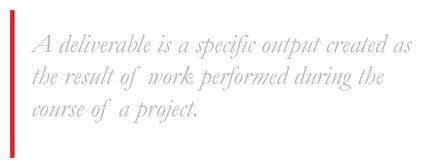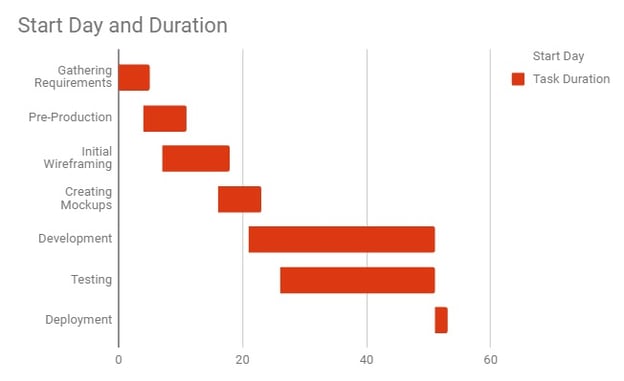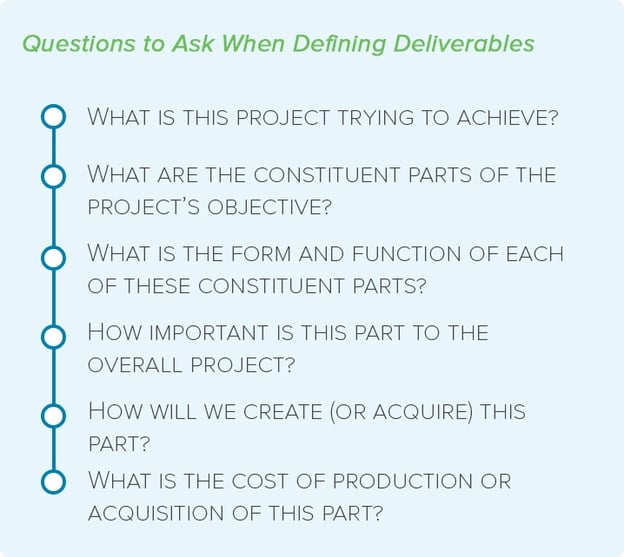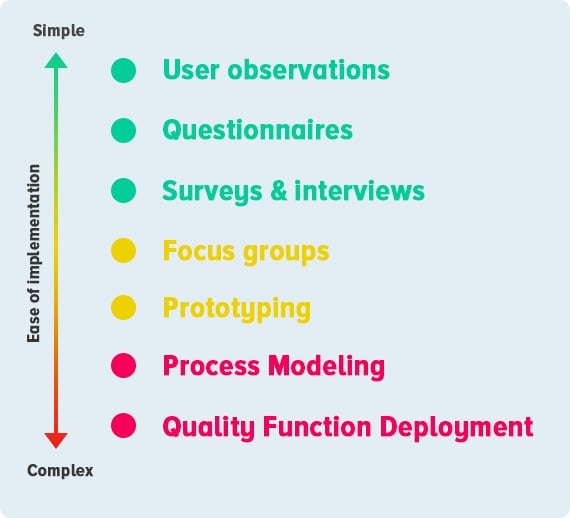You might use the term “deliverable” casually at work every day.
In project management, the definition of deliverables is more definite: a specific output created as the result of work performed during the course of a project.
What are Project Deliverables?
A deliverable in project management is any output created as the result of work done during a project. Defining, tracking, and managing project deliverables is one of a project manager's most important responsibilities. This guide will help you understand project management deliverables in more detail.
For any parts of a project to be classified as a “deliverable,” they have to meet a few criteria:
- It must be within the scope of the project
- Stakeholders - external or internal - must agree to it
- It must be the result of deliberate work
- It must have a definite role in accomplishing the project’s objective
For example, a creative team might create a number of documents during the course of developing a new website.

Some of these - such as a designer’s casual sketches - are neither critical for the project’s objective nor the result of deliberate work. Hence, you wouldn’t classify these as deliverables.
On the other hand, your developers can’t really proceed if they don’t have a website wireframe. Since the wireframe results from deliberate, objective-focused work, you would classify it as a deliverable.
Anything can be a deliverable in a project. A bicycle and a document outlining the plan to create it can be deliverables.
The deliverable can be massive and tangible, such as a stadium or a factory, or tiny and intangible, such as a one-page marketing document.
Project deliverables can be created for both external and internal stakeholders. An example of the former would be the website you make for a client. A design requirements document would be an example of the latter.
Deliverables can also be “stacked”, i.e. one deliverable might have several of its own deliverables. A “website” might be your primary objective. To create it, you might have two additional deliverables - “website wireframe” and “website mockup.”

This also means that deliverables can depend on one another. You can’t create a website mockup unless you have a wireframe. And you can’t create the actual website until you’ve finalized the mockup.
Deliverables alone aren’t the project’s objective. Rather, they chart the path to reach it. The more deliverables you complete on time, the better your chances of meeting the project’s goals on schedule as well.
This is why project managers often focus obsessively on the deliverables—on defining, managing, and tracking them.
Internal vs External Deliverables
A common way to categorize deliverables is to divide them into “external” and “internal” deliverables. There’s an easy method for defining them:
- Any work done that is not a part of doing business with clients or customers is an internal deliverable
- Any work done to fulfill a client’s demands or to win more business is an external deliverable
You can think of internal deliverables as anything you create as a part of running the business. Doing taxes, keeping accounts, and creating corporate documents - are all internal deliverables. You need them to run the business, but they don’t really generate revenue.
As Nick Austin Lee of Flowbit says:

Most of the time, you would know whether a deliverable is internal or external based on who it is created for. But if you’re unsure, just ask yourself: “Is this deliverable going to leave the organization?”
If the answer is “yes”, then it would be an external deliverable.
Deliverables vs. Milestone
Another source of confusion for new project managers is the difference between project milestones and deliverables.
Milestones are checkpoints in the course of a project. You can insert them at any point to mark the completion of an important activity. They don’t have deadlines, nor do they have an impact on the project’s objectives. They are simply a way to keep track of the project’s progress.
You’ll create milestones to break down a complex deliverable into its constituent parts. For example, if your deliverable is to create a set of “high-level requirements”, one of your milestones might be “document current processes”.

Gantt charts in Workamajig help you keep track of milestones
Milestones aren’t meant for clients; they’re meant for the internal project team. You can include them in the project status report but it’s not essential to do so.
Project vs. Process Deliverables
There is yet another distinction you need to make regarding deliverables: project vs process deliverables.
Project deliverables are the big, client-focused accomplishments we talked about earlier.
Process deliverables describe the path that will help you create the project deliverables.
Think of all the documents you create in the course of managing a project. You'll start off with a project scope statement, create a project plan, and develop a work breakdown structure.
These documents are seldom client-facing. Instead, they're created for internal stakeholders and the project team to help manage the project better. You can run a project well without them, though you'll likely have difficulty reaching your objective.
All these documents are examples of process deliverables. Creating them isn't the project's goal, but it does make reaching the goal much easier.
Some examples of process deliverables are:
%20for%20Project%20Success-3.png?width=624&height=388&name=7%20Proven%20Steps%20to%20Mastering%20Work%20Breakdown%20Structure%20(WBS)%20for%20Project%20Success-3.png)
A work breakdown structure (WBS) is an example of a process deliverable.
IMPORTANCE OF TRACKING PROJECT DELIVERABLES
Tracking project deliverables can be a lot of work. Done well, however, it can allow you to maximize several benefits, including:
Efficient Scheduling
By ensuring that all project deliverables are properly defined, documented, and tracked, you can create good project schedules that are accurate and achievable. This will help you stay on track with your project timelines and ensure that you meet your project goals and objectives.
It is important to identify all of your project deliverables upfront so that you can manage them effectively throughout the project lifecycle. By doing so, you will reduce the risk of scope creep, minimize project delays, and ultimately deliver a successful project that meets or exceeds stakeholder expectations.
Accurate Estimates
Properly managing project deliverables can enable you to create accurate estimates essential for effective project planning. With accurate estimates, you can better allocate resources, manage risks, and deliver results that meet or exceed stakeholder expectations. You can also ensure that you’re charging your clients the right price for the amount of work your team is about to do.
Read more: The Creative Agency Guide to Creating a Project Budget
Resource Management
Clearly defining and documenting project deliverables can help you facilitate a clear understanding of what needs to be accomplished and by when. This, in turn, allows you to properly plan and manage resources.
When you have a well-defined set of deliverables, you can allocate resources effectively, which can save time and money.
Read more: Creative Resource Management for Agencies: Software + FAQs
Team Alignment
For your project to succeed, it’s important for you and your team to stay focused on your goals and be aligned in your efforts. When everyone is on the same page, it becomes easier to work towards a common objective and the chances of success increase manifold.
By keeping track of your deliverables, you can ensure that each task is completed within the set deadline and in a manner that meets the project's requirements. Effective communication and collaboration are crucial in managing project deliverables, and by doing so, you can help your team stay motivated and aligned toward achieving success.
Stakeholder Expectations
Managing deliverables can help you stay organized and ensure that you are meeting the expectations of your stakeholders. By aligning expectations with stakeholders, you can avoid confusion and miscommunication. This is crucial in maintaining healthy professional relationships which can result in better communication and client loyalty.
Risk Projection
Prioritizing the management and documentation of project deliverables not only helps you keep track of progress but also enables you to prepare for potential project risks. By having a clear understanding of what has been completed and what still needs to be done, you can make informed decisions about resource allocation and identify areas that require additional attention.
Project Deliverables Examples
As you've seen so far, project deliverables can be of any type - tangible and intangible, big and small, internal and external. They can describe the project's goals or the path to reach those goals.
To help you understand them even better, there are a few examples of project deliverables:
- A SWOT analysis of a competitor to identify opportunities. Can be for internal or external stakeholders.
- A work breakdown structure was created at the start of a house construction project.
- A project scope statement that will guide the internal project team and define the project for external stakeholders.
- A gap analysis report was created to identify weaknesses and opportunities when compared to a competitor.
- A design presentation was made for the clients to help them understand the project's goals.
- A website wireframe was made for the development team.
- An inspection report is created during a construction project that the client will use for compliance purposes.
- An eBook created by the marketing team to promote a new product.
- A whitepaper created by the development team to help clients understand a new product.
- A document detailing the quality control process a factory will use to ensure products are up to the client's standards.
- A Gantt chart is created at the start of a project to define its timeline and milestones.
These are just some project deliverables examples. You can have virtually anything as a deliverable as long as stakeholders agree to it. If it is the product of deliberate work and helps you reach the project’s objective, it can be classified as a deliverable.

A Gantt chart is an example of a process deliverable (if it isn’t shared with the client) as well as a project deliverable (if it is shared with the client)
In the next section, I’ll cover the more important parts: how to define project deliverables and how to manage them.
Defining Project Deliverables
All deliverables - project and process - have two components:
- The specific deliverable
- The acceptance criteria for the deliverable
For example, if you’re implementing a content management system (CMS) for a client, one of your deliverables might be:
- Create a training program to help employees understand and use the CMS
Before this deliverable can be accepted, however, it must meet both the client’s and the internal stakeholders’ requirements:
- Internal requirements: The training program must have agency branding.
- External requirements: The training program must be at least 20 hours long and include a questionnaire to evaluate user knowledge post-completion.
These requirements would be the deliverables’ “acceptance criteria”.
So, how does one go about defining both the deliverables and their acceptance criteria?
I’ll share a process for doing so below:
Project Deliverables Definition Process
To define the project deliverables, you have to work backward from the objective. Figure out what you need to do. Then figure out the requirements that will make the deliverable acceptable.
To define the deliverables, start by asking the following questions:
- What is this project trying to achieve?
- What is the purpose, goal, or end result the client wants once the project closes?
- What are the constituent parts of the project’s objective?
- What is the form and function of each of these constituent parts?
- How important is this part to the overall project?
- How will we create (or acquire) this part?
- What is the cost of production/acquisition of this part?
- How much time will it take to produce/acquire this part?
Essentially, you’re decomposing the project’s objective into smaller parts. At the same time, you’re evaluating the feasibility and priority of each constituent part. Refer to your work breakdown structure - if you have one - to help define the deliverables.

Gathering Requirements for Deliverables
You’ll find that defining the deliverables is fairly easy. The harder part is defining the requirements for each deliverable.
Requirements specify the criteria that make a deliverable acceptable. If the requirements are incomplete, clients will request changes and revisions. This can increase the project’s scope and budget, eating into your profits.
A key step in the deliverables definition process, therefore, is gathering requirements.
For example, if you’re setting up a CMS, it needs to meet the following requirements:
- Create, edit, and manage documents
- Import existing documents
- Integrate with the client’s existing email system
- Include training programs for end-users
If the deliverable, i.e., the CMS, does not meet these requirements, clients might reject it, leading to scope changes.
There are several tactics you can adopt to gather requirements. These can be simple (“user observations”) or complex (“quality function deployment”).

In creative projects, subjective processes such as interviews, user observations, questionnaires, etc., are particularly helpful in gathering requirements.
Regardless of the tactic you use, there are a few questions you should ask when evaluating the requirements for each deliverable:
- Who are the key stakeholders who need to sign off on this deliverable?
- What are the stakeholders’ top priorities for this deliverable?
- Are these requirements within the project’s scope and budget? If not, how much will the scope/budget need to be expanded to accommodate them?
- Have we created similar deliverables in the past? What were their requirements?
- What is the industry standard for these deliverables?
- Who is the end-user for this deliverable? What will make it a success for them?
- What are the minimum quality criteria this deliverable must meet to be successful? How do you measure it?
Besides the specific requirements for each deliverable, there will also be some “universal” requirements. These are usually best practices followed across the industry or your agency.
For instance, if you’re creating a website for a client, it must pass W3C’s markup validation requirements.
Similarly, every marketing document must carry the agency’s branding and contact information.
Defining Process Deliverables
Apart from the above, you also need a number of process deliverables to create the project deliverables. You’ll use these to keep track of the deliverables and ensure they meet all requirements.
Most agencies will already have standard practices when it comes to defining these deliverables. For instance, you might have a fixed template for work breakdown structures, project plans, statements of work, etc.
Nevertheless, here are some questions you need to ask when you define process deliverables:
- What process deliverables will be required to complete the project’s objective?
- Who will be responsible for the planning, implementation, and maintenance of each deliverable?
- How will you track and manage each deliverable?
- When is each deliverable due? For recurring deliverables, what will be the frequency and date of each check-in?
- Who is responsible for signing off on each deliverable?
For example, you need all stakeholders to sign off on the statement of work (SoW), a key process deliverable. Asking questions like the above will help you figure out the specific stakeholders, their requirements, and the due dates.
Common Challenges In Managing Project Deliverables
Scope Creep
Scope creep refers to the gradual expansion of project requirements beyond the original scope, which can lead to delays, budget overruns, and poor quality results. Scope creep makes it challenging for project managers to manage deliverables because it can constantly disrupt a team’s workflow and ruin initial plans.
Lack Of Accountability
In any project management scenario, accountability is crucial for ensuring the successful delivery of project deliverables. When there is a lack of accountability, it becomes a challenge to manage the project deliverables effectively.
Accountability ensures that the team members are responsible for their assigned tasks and are held accountable for meeting the deadlines. Without accountability, there is no sense of ownership or responsibility, which can lead to missed deadlines, incomplete work, and overall project failure.
Poor Communication
When team members aren't transparent about their progress and when feedback isn't relayed properly, it can lead to confusion, misunderstandings, and delays in project completion. This can have a negative impact on the overall project outcome, budget, and timeline.
Lack Of Clarity
Without clear parameters around project deliverables, managing them can become incredibly challenging. When stakeholders are unclear about what they expect from the project, it can lead to confusion and misunderstandings about what constitutes a successful outcome. This lack of clarity can lead to missed deadlines, budget overruns, and ultimately project failure.
Inaccurate Estimates
Inaccurate estimates can pose significant challenges, making it difficult to manage project deliverables effectively. For instance, underestimating the required time and resources can lead to missed deadlines, overworked team members, and compromised quality of deliverables. On the other hand, overestimating can result in unnecessary delays, idle resources, and increased project costs.
Tips for Managing Project Deliverables
Following these simple tips can make managing project deliverables easier:
- Define the deliverables before you start your work. Adding deliverables once the work has already started will change the project's scope and budget.
- Be thorough when gathering requirements for each deliverable. The better you understand the requirements, the easier it will be for stakeholders to accept the deliverables.
- Figure out whether a deliverable is meant for internal or external stakeholders. You have more leeway in the case of the former.
- Decompose the project's objective to uncover your key deliverables. Before beginning work, however, make sure that you get stakeholders to sign off on each deliverable.
- Involve stakeholders in the project initiation meeting and seek their input when defining deliverables and their acceptance criteria.
- Segregate deliverables into distinct phases to help you track them better.
- Question stakeholders as well as end-users to better understand the requirements for each deliverable.
- Identify the metrics you will use to measure the acceptability of each deliverable upfront. This will help avoid changes in the deliverables later.
- Identify the deadline for each deliverable. Tie these to milestones to ensure better tracking.
- Include a list of deliverables, their deadlines, and the project team responsible for each deliverable in the project plan.
- Use creative project management software like Workamajig to make tracking and managing project deliverables easier.
- Keep a clear distinction between deliverables and milestones, and between process and project deliverables.
- Whenever possible, use standardized process deliverables.
- When gathering requirements, ensure that they meet the SMART goals criteria.
This guide is by no means exhaustive. Every project manager must develop his own process for defining and managing deliverables. This will depend on your own working style as well as the limitations & capabilities of your project team.
How To Manage Your Project Deliverables With Workamajig

Source: Workamajig Tutorial On Deliverables
One way to make managing deliverables easier is to use project management software like Workamajig.
Start by entering the details of your new deliverable for your project. Include important details such as its name, description (success criteria and other important details), what task it’s related to, owner, due date, and whether or not you’ll have it internally reviewed or externally approved as well.

Source: Deliverables In Workamajig
Workamajig breaks deliverables into “rounds” and “steps.” You send out deliverables for review (internally or externally) in “rounds,” and each revision request is handled in “steps” within each round. This makes it easy to keep track of deliverables and ensure that they meet the acceptance criteria.

Use annotation tools to comment on specific areas of the files.
The platform allows you to upload files and identify your internal reviewers and external reviewers. Once those are set, you can create automated reminders in addition to the reports Workamajig generates to help you stay on top of which reviewers you’re still waiting for feedback from. Workamajig also has an efficient annotation tool to ensure smooth communication.
Learn how Workamajig can improve your operational efficiency.
Related reads:
- Creative Workflow Management: Best Practices + Software Tools
- All-in-One Agency Software
- Best Marketing Operations Management Software
Originally published 5/1/2018. Updated 8/11/24.

